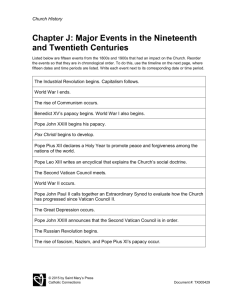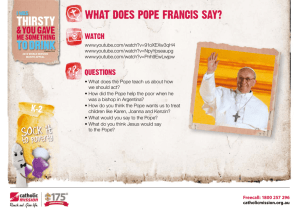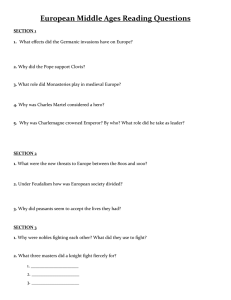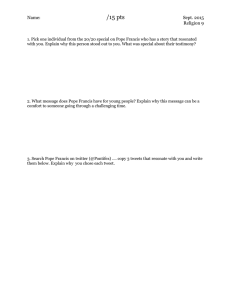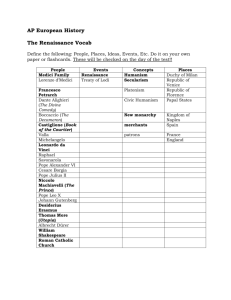French Revolution to World Wars: A Historical Overview
advertisement
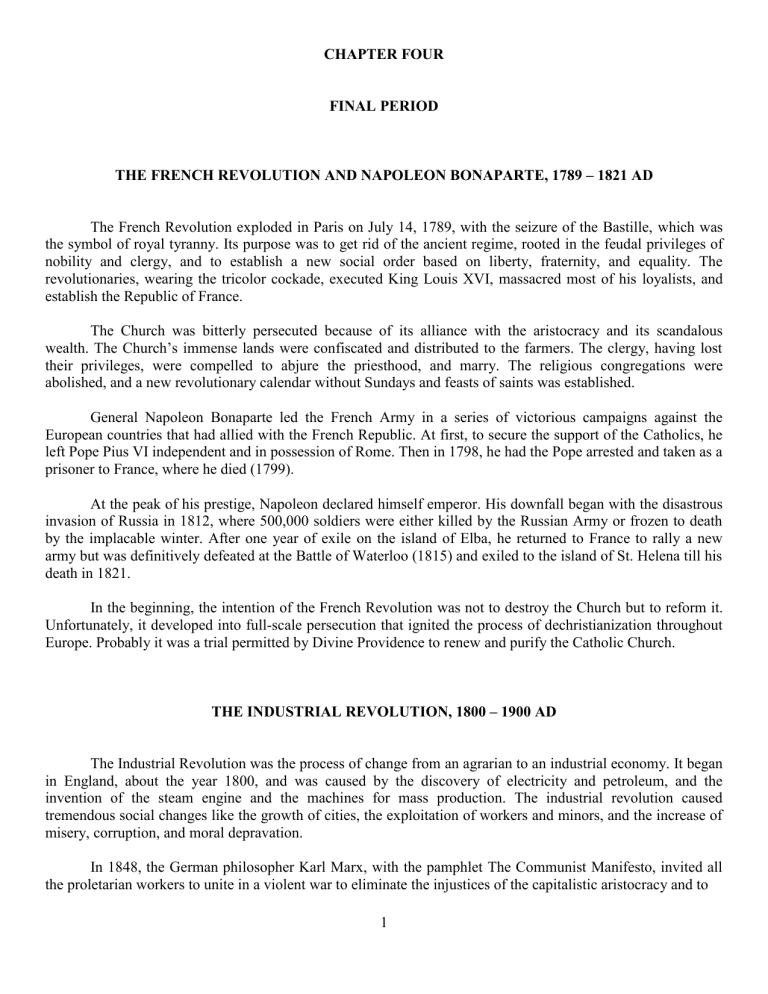
CHAPTER FOUR FINAL PERIOD THE FRENCH REVOLUTION AND NAPOLEON BONAPARTE, 1789 – 1821 AD The French Revolution exploded in Paris on July 14, 1789, with the seizure of the Bastille, which was the symbol of royal tyranny. Its purpose was to get rid of the ancient regime, rooted in the feudal privileges of nobility and clergy, and to establish a new social order based on liberty, fraternity, and equality. The revolutionaries, wearing the tricolor cockade, executed King Louis XVI, massacred most of his loyalists, and establish the Republic of France. The Church was bitterly persecuted because of its alliance with the aristocracy and its scandalous wealth. The Church’s immense lands were confiscated and distributed to the farmers. The clergy, having lost their privileges, were compelled to abjure the priesthood, and marry. The religious congregations were abolished, and a new revolutionary calendar without Sundays and feasts of saints was established. General Napoleon Bonaparte led the French Army in a series of victorious campaigns against the European countries that had allied with the French Republic. At first, to secure the support of the Catholics, he left Pope Pius VI independent and in possession of Rome. Then in 1798, he had the Pope arrested and taken as a prisoner to France, where he died (1799). At the peak of his prestige, Napoleon declared himself emperor. His downfall began with the disastrous invasion of Russia in 1812, where 500,000 soldiers were either killed by the Russian Army or frozen to death by the implacable winter. After one year of exile on the island of Elba, he returned to France to rally a new army but was definitively defeated at the Battle of Waterloo (1815) and exiled to the island of St. Helena till his death in 1821. In the beginning, the intention of the French Revolution was not to destroy the Church but to reform it. Unfortunately, it developed into full-scale persecution that ignited the process of dechristianization throughout Europe. Probably it was a trial permitted by Divine Providence to renew and purify the Catholic Church. THE INDUSTRIAL REVOLUTION, 1800 – 1900 AD The Industrial Revolution was the process of change from an agrarian to an industrial economy. It began in England, about the year 1800, and was caused by the discovery of electricity and petroleum, and the invention of the steam engine and the machines for mass production. The industrial revolution caused tremendous social changes like the growth of cities, the exploitation of workers and minors, and the increase of misery, corruption, and moral depravation. In 1848, the German philosopher Karl Marx, with the pamphlet The Communist Manifesto, invited all the proletarian workers to unite in a violent war to eliminate the injustices of the capitalistic aristocracy and to 1 establish a communist society. The Church, considered the opium of the people and an ally of capitalism, was to be eliminated as well. Marx’s Manifesto closed with the famous words: The proletarians have nothing to lose but their chains. They have a world to win. Working men of all countries, unite! The Church’s social teaching, which was synthesized in the encyclical Rerum Novarum of Pope Leo XIII (1891), opposed both capitalism and communism and asked for a social order based on the Gospel’s teaching. Many Christian heroes, like St. John Bosco, inflamed the people into a peaceful fight for charity and social justice. Their struggle against misery was based on the conviction that man is composed of body and soul, and that one cannot free the first from abuses unless the second is liberated from sin. St. John Don Bosco, the founder of the Salesians, was born near Turin in 1815. Coming from a poor family, he experienced the many hardships of farmers and factory workers. After his ordination in 1841, he was assigned to Turin, the industrial capital of northern Italy, where he worked for the youth and the street children. He opened the famous Oratory of St. Francis de Sales where they could learn a job and the basics of the Christian life. His ambition was to make honest citizens and good Christians. Besides the workshops for shoemaking and tailoring, he opened a printing press for the mass production of catechetical and religious pamphlets. He was the first to defend the rights of minors against the abuses of their employers, and to request a formal contract for them. So successful was his work among homeless youth that even the most anticlerical politicians honored him. At his funeral, in 1888, thousands of persons came to express their gratitude for that loving father, who had given them the dignity of honest work and the nobility of the Christian faith. THE LAST POPE-KING, 1870 AD Pope Stephen II became king of the States of the Church in 756 when the Frankish king Pepin the Short snatched various territories in central Italy from the Longobards and the Byzantines and handed them over to the Papacy. The royal status, which lasted until 1870, forced the Pope to set up his army, ally with other states, and become involved in politics. Rome always enjoyed the constant flow of pilgrims and tourists, but the Papal States suffered economic depression, endemic brigandage, and the abuses of aristocratic families. Agriculture, industry, and trade remained static. Moreover, since the papal authority was based on divine right, any criticism was regarded as disrespect towards God himself. The outbreak of the French Revolution in 1789 quickly changed this situation. Many activists arrived in Rome to propagate revolutionary ideas and found many sympathizers among the intellectuals. In 1796, when Napoleon invaded Italy, Pius VI was carried off a prisoner to France, and the States of the Church were incorporated into the French Empire. Young men fled military conscription and formed wandering bands of highway robbers. After the Fall of Napoleon in 1814, the Congress of Vienna restored to Pius VII the confiscated lands. 2 The movement for Italian unification, known as Risorgimento, pressed for incorporating the papal territories into the kingdom of Italy. In 1848, a patriotic insurgency forced Pius IX to flee Rome and take refuge in Gaeta. The French soldiers came to his rescue and remained thereafter in Rome against future attempts. In 1860l the kingdom of Italy annexed most of the Papal States. Finally in 1870, when the French-Prussian War demanded the withdrawal of the French garrison, the Italians took Rome after some hours of cannonading, breaching the Porta Pia, Victor Emmanuel II, king of Italy, proclaimed Rome the new capital and formally ended the States of the Church. The Papacy continued to contest the loss of its territorial sovereignty until 1929 when the Lateran Treaty created the independent state of Vatican City. The Church was finally liberated from her temporal power, which was an embarrassing liability for her spiritual mission. It took more than a thousand years to understand that the Church’s treasures are not properties and wealth, but the Gospel and the poor. WORLD WAR I, 1914 – 1918 AD World War I began with the killing of Austrian Archduke Francis Ferdinand at Sarajevo, on June 28, 1914, by a Bosnian Serb. The assassination set in motion a chain of threats and ultimatums that mobilized the whole of Europe. The Central Powers (Germany, Austria-Hungary, and Turkey) confederated themselves against the Allies (England, Russia, Italy, Japan, and United States). It was a war of attrition fought from lines of trenches, and any flanking maneuver or frontal assault caused thousands of casualties. Among the deadly innovations of the war were fighting aircraft, long-range bombers, tanks, and poisonous gas. Germany’s most lethal weapons were the U-boat submarines, which sank any ship crossing the Atlantic Ocean. Despite the withdrawal of Russia from the conflict in 1917, after the October Revolution, the Great War ended with the complete defeat of the Central Powers. The Treaty of Versailles (1919) ratified the collapse of the Austrian-Hungary Empire and imposed heavy penalties on Germany. In six years of the war, 21 million people were wounded and more than 10 million died. Was the Great War worth that carnage? Pope Benedict XV, whose appeal for peace was rejected by the nations at war, did everything he could to alleviate the misery of the war. In Vatican City, he instituted the international bureau for missing persons to reestablish contact between prisoners of war and their families and helped thousands of wounded soldiers to recover their health. After the war, the people of Constantinople erected a memorial sculpture of the Pope, whose inscription says: The Eastern Church erects this thanksgiving statue to the Pope of the Great War, benefactor of all peoples, without discrimination of nationality and religion. 3 WORLD WAR II, 1939 – 1945 AD World War II was instigated by the German dictator Adolf Hitler in 1939. The conflict, which involved virtually every part of the world, was fought between the Axis Powers (Germany, Japan, and Italy) and the Allied Nations (France, Great Britain, United States, and Russia). In a few months, because of an impressive combination of dive bombers, high-speed tanks, and armored vehicles, the Germans occupied Poland, France, and other smaller European states. At the same time, they started a submarine campaign in the Atlantic Ocean and launched massive bombing raids on England. Hitler established the notorious concentration camps for the extermination of millions of Jews, gypsies, and prisoners of war. Women, children, and disabled persons were immediately stripped of their clothes, killed inside the gas chamber, and cremated. Others were first worked out, starved to death, exposed to any sort of humiliation, or killed by a bullet in cold blood. The extermination camps, like Majdanek, Treblinka, and Auschwitz, were under the administration of the Blackshirt's SS, the elite guard of Hitler. It was in Auschwitz that Maximilian Kolbe, founder of the Militia of Mary Immaculate, won the crown of martyrdom. In 1941, because of his active support for the Jewish refugees, he was arrested by the Gestapo, the secret German police, and deported to a concentration camp. On July 31, 1941, ten randomly picked men were to die in the starvation cell in reprisal for a prisoner's escape. Fr. Kolbe offered himself in place of one of them. On August 14, 1941, after two weeks of horrible pains, he was injected with carbolic acid and cremated. The Axis Powers’ first defeat was in North Africa and Russia (1942 – 43). Henceforth, the Germans started a bloody withdrawal from all fronts. The Allies landed in Sicily and Normandy, while the Russians moved westwards towards the German mainland. In May 1945, with Berlin encircled by Allies’ troops, Hitler committed suicide and Germany signed an unconditional surrender. On December 7, 1941, the Japanese made a surprise attack against the United States Navy in Pearl Harbor in Hawaii. A few days later, they began the occupation of the Philippines. Under the supreme command of Gen. Douglas MacArthur, the Filipino American Forces withdrew to Bataan and Corregidor, where they heroically held their ground. Five months later, short of ammunition, food, and medicines, the survivors surrendered to the Japanese Imperial Forces and were forced to start the merciless Death March to Pangasinan. MacArthur’s promise, I shall return, became the rallying cry of the guerilla movement. On October 20, 1944, MacArthur landed in Palo, Leyte, and began the American counter-offensive. Manila was liberated on March 3, 1945, and the rest of the Philippines within a few months. The capture of Iwo Ima and Okinawa opened the way for the invasion of Japan. The war came to a sudden close after the atomic bombing of Hiroshima and Nagasaki, which forced Japan to sign an unconditional surrender to the American forces on September 2, 1945. The Church committed its forces to the relief of all men, unmindful of their citizenship or belief. Thanks to Pope’s intercession, Rome was spared from aerial bombing and declared an open city. The Vatican became a relief center for prisoners of war and refugees. Thousands of Jews were saved. Some found refuge inside churches and convents, others were secretly sent overseas. When the bloodiest war of all time was over, leaving behind 50 million dead, the world remembered the prophetic words spoken by Pius XII a few days before it began: Nothing is lost by peace; everything is lost by war. 4 THE FOUR LATEST POPES, 1962 – 2000 AD John XXIII (1958 – 1963) was born in Sotto il Monte (Italy) in 1881. Angelo Giuseppe Roncalli was never ashamed of his lowly origins and always retained his peasant optimism. At the time of World War I, he was a respected chaplain and a most beloved father. Appointed Papal Nuncio in Turkey, Greece, and Paris, he remained on friendly terms with people of every race and religion. During World War II, he worked to provide food and medicines for the needy and to prevent the deportation of Jews. In 1953 he was appointed Cardinal of Venice, where he soon won the affection of all people. Five years later, after the death of Pius XII, he was elected Pope with the name John XXIII. He chose that name in gratitude to the patron saint of the little parish where he was baptized. The major achievement of his pontificate was the opening of the Second Vatican Council, on October 11, 1962, which was attributed to a sudden inspiration from the Holy Spirit. The Council, attended by 2,500 Catholic Bishops and guests from Protestant and Orthodox denominations, was like a new Pentecost for the renewal of the Church. Among the many innovations were the celebration of the Mass with the priest facing the assembly; the promotion of the Bible for all Christians in local languages; the ecumenical drive, the promotion of the apostolate of the laity, and the recognition of new charisms and movements in the Church. Considered a transitional man, because of his age and simplicity, John XXIII was the man chosen by the Holy Spirit to initiate a new age in the history of the Church. Paul VI (1963 – 1978), the son of a wealthy Italian lawyer, was a man of fine study and diplomacy. After his appointment to the diocese of Milan, Giovanni Battista Montini was called the Bishop of the workers, because of his constant concern for the industrial laboring class. Elected Pope in 1963, he continued the Second Vatican Council, which he solemnly closed on December 8, 1965. Then he began implementing the Council’s decisions with great courage and enthusiasm. He was able to guide the Church through a period of revolutionary change without schism. His most controversial encyclical was Humanae Vitae (1968), condemning artificial methods of birth control. He traveled throughout the world and was the first reigning Pope ever to use the airplane. During his missionary journey to the Philippines, he survived an assassination attempt. The Pope of the workers and the poor died on August 6, 1978, and was buried in the crypt of St. Peter’s Basilica. John Paul I (August 26 – September 28, 1978) His pontificate lasted only 33 days. Born in 1912 in a little town near Belluno (Italy), Albino Luciani came from poor, working-class parents and was always regarded as an excellent priest. In 1969, largely in response to local demand, he was named patriarch of Venice. He encouraged his priest to sell precious vessels for the benefit of the poor and to give one percent of their income to the third-world churches. His election as Pope was surprisingly fast and was welcomed with great enthusiasm. John Paul, I was indeed a person who radiated joy and optimism. He was popularly known as the Smiling Pope. His papal name expresses the desire to combine the progressive qualities of John XXIII and the traditional ones of Paul VI. He died of a heart attack while lying in bed reading some personal papers. His light was still on when he was found dead at about 5:30 AM the next day. Rumors that he was poisoned because he planned to clean up the Vatican Bank are columnists’ fantasies. In the plan of God, it was just fitting that John Paul I should give a short but memorable example of evangelical simplicity and holiness. 5 John Paul II (1978 - 2005), the first non-Italian Pope after 500 years, was born to a modest family in Wadowice, Poland on May 18, 1920. Karol Wojtyla, nicknamed Lolek, was an outstanding student and a fine sportsman. During the Nazi occupation of Poland, he worked in a mine and a chemical plant. Beginning in 1942, he discovered his vocation for the priesthood and, since the Germans had closed the Krakow seminary, he studied theology secretly. After he was appointed Cardinal archbishop of Krakow, he became a leading figure in the Church. He was elected Pope on October 16, 1978, at the young age of 58. On May 13, 1981, while riding the papal jeep in St. Peter’s Square, John Paul II was shot and seriously wounded by a young Turk. The following year he went on a pilgrimage to Fatima to present the bullet to the Virgin Mary and to give thanks for deliverance from assassination. He also went to prison to visit and forgive his would-be murderer. John Paul II will enter history as the Pilgrim Pope because his pontificate has been highlighted by several missionary journeys all over the world. One of the major achievements of his pontificate was the launching of the New Catechism of the Catholic Church in 1992. It was a memorable event if we consider that the former official catechism was the one of the Council of Trent. Even if many accused him of being a conservative person, he has restored to the Church a strong missionary drive and a clear sense of direction which were endangered by wrong interpretations of the Second Vatican Council. THE CHURCH IN THE PHILIPPINES, 1989 – 2000 AD In 1872, three diocesan priests, Gomez, Burgos, and Zamora, were executed for alleged complicity in a mutiny of native garrison troops. This gave a powerful impetus to the independence movement led by Dr. Jose Rizal, who was himself arrested and executed for treason in 1986. The ensuing revolution and independent government (1896 – 98), led by Andres Bonifacio, Emilio Aguinaldo, and other Katipuneros, were cut short by the intervention of the United States, which obtained the Philippines from Spain after the Spanish-American War. The Americans began the policy of separation between Church and State and opened the gate to Protestant missions. One consequence of the revolution was the formation 1902 of the Philippine Independent Church. In 1898 Emilio Aguinaldo and other Filipino leaders, wishing to overthrow the spiritual and political power of the Spaniards, persuaded Gregorio Aglipay, a Filipino priest, to create a local church. Aglipay became the supreme bishop and had himself consecrated by 12 schismatic priests. The doctrines of the Philippine Independent Church were contained in the books of Isabelo de Los Reyes, a Philippine Senator who returned to the Catholic Church in 1936. In 1920, Felix Manalo founded the Iglesia ni Kristo. This religious group, despite the name, cannot be considered Christian because it does not believe in the divinity of Christ nor the reality of the Trinity. During World War II (1941 – 45), the Church did not compromise with the Japanese occupation. Several priests and religions refused to cooperate with the Japanese and were interned in camps. Those who 6 manage to escape to the hills and continued their ministry among guerillas and refugees. The Archbishop of Manila, Michael J. O’Doherty, was kept under house arrest because he refused to ask the people on a radio address to cooperate with the invaders. At the end of the war, the Philippines were granted full independence and sovereignty. Despite the problems left behind by three years of Japanese military occupation, the newly born republic succeeded in making the Philippines the most respectable country in Asia. In 1965, Ferdinand Marcos was elected president. Seven years later, he declared Martial Law and closed most newspapers and broadcasting stations. Martial Law was formally ended in 1981, but Marcos retained absolute emergency powers. In 1983, the assassination of Senator Benigno Aquino at Manila airport led to mass demonstrations against the regime, which exploded in 1986 with the famous EDSA Revolution. The people of Manila, openly supported by the outspoken Jaime Cardinal Sin, were able to stop tanks and machine guns with their people's power, flowers, and prayers. Marcos fled to Hawaii and Corazon Aquino widow of the murdered Benigno and herself a devout Catholic, became president. The 1987 Philippine Constitution subscribed to the principle of separation of Church and State and granted religious freedom to all churches and denominations. Paul VI was the first Pope to visit the Philippines in 1971. John Paul II in 1981 and 1995 for World Youth Day which was celebrated in Manila on January 10 – 15, 1995. The Pope was so impressed by the youth that he uttered a memorable statement: The Filipinos are phenomenal people! 7
